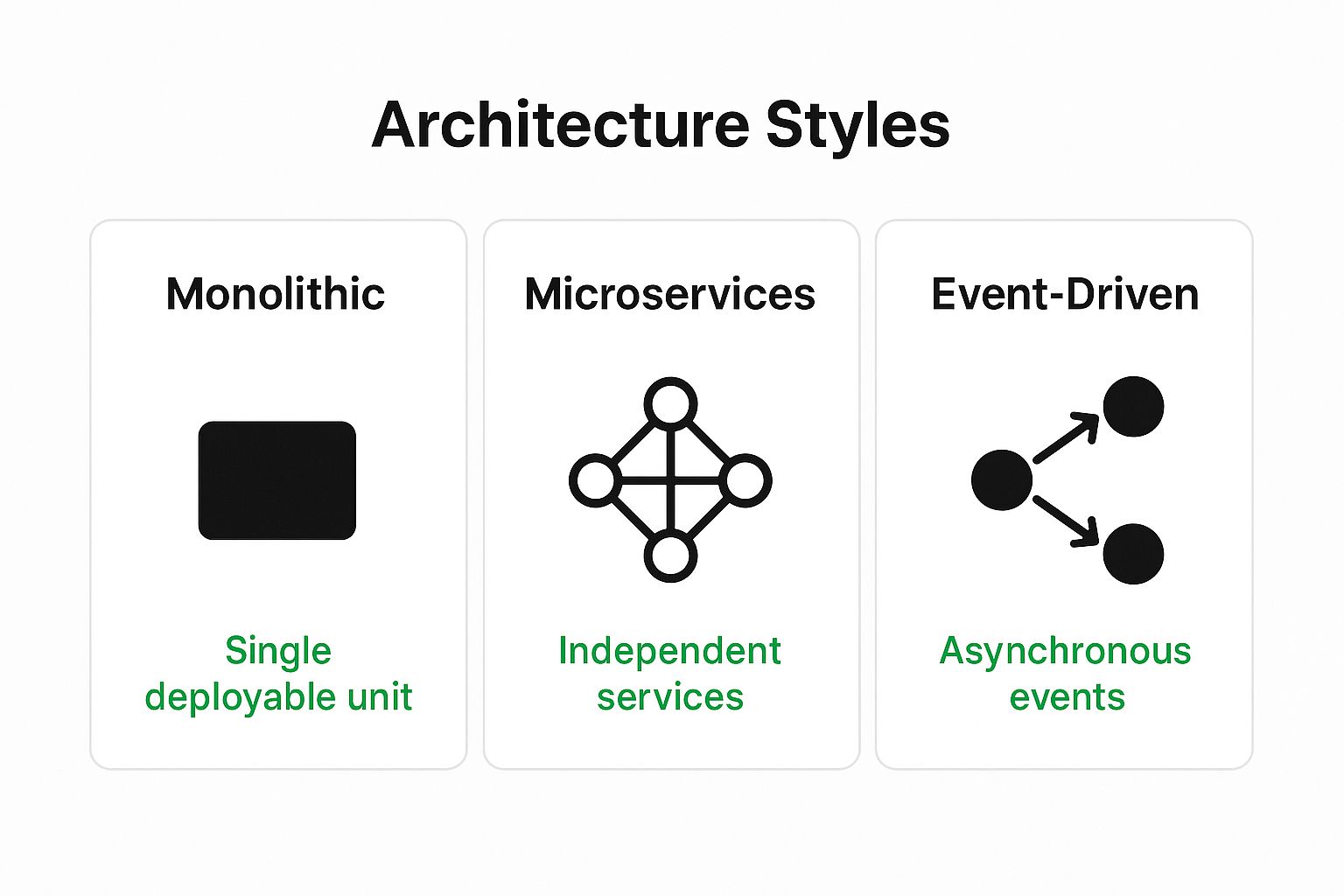Discover what is software architecture and why it's crucial for success. Learn core principles, patterns, and its impact on business outcomes.
So, what is software architecture, really? At its heart, it’s the high-level game plan for a software system. Think of it as the collection of big, foundational decisions that define what the major pieces are, what they’re responsible for, and how they all talk to each other to get the job done.

It’s tempting to think of software architecture as a rigid building blueprint, but that’s not quite right. A better analogy is a city’s master plan. A city plan doesn’t sweat the small stuff, like the color of every front door or the furniture inside each house—those are implementation details, just like individual lines of code.
Instead, the plan focuses on the critical infrastructure that allows the city to actually function and grow. It lays out the road networks, sets up zoning for residential and commercial districts, and designs the grids for power and water. These are the make-or-break decisions that determine how the city will manage traffic, expand over the years, and ultimately, be a place people want to live.
Just as a city plan prevents total chaos, software architecture provides the strategic vision that keeps a system from collapsing under its own weight. It’s all about tackling the “big rocks” first, making sure the entire structure is built on a solid foundation.
These foundational decisions usually center on what we call “non-functional requirements” or quality attributes. These are the characteristics that dictate how well the system works, not just what it does. This includes things like:
In the end, good architecture is what separates a system that can evolve from one that becomes brittle, fragile, and a nightmare to change. It’s the essential discipline behind any successful custom software development project, ensuring it has a long and healthy life.
To make sure everyone is on the same page, teams need to communicate this vision clearly. We’ve put together a guide with a powerful software architecture documentation template you can use to get started: https://www.docuwriter.ai/posts/software-architecture-documentation-template. By making these strategic calls early on, you avoid the digital equivalent of perpetual traffic jams and crumbling roads, building a system that’s robust and ready for whatever the future holds.

To really get why software architecture is so critical today, it helps to rewind the clock a bit. This discipline wasn’t just invented on a whim; it was forged in the fires of a full-blown crisis that hit the software industry hard.
Back in the 1980s and early 1990s, the ambition of what we wanted software to do started to seriously outpace our methods for building it.
Projects ballooned in size and complexity. The casual, “we’ll figure it out as we go” approach that worked for small, self-contained applications began to fail—and fail spectacularly. Teams were building digital houses of cards. A small change in one corner of the system would trigger a chain reaction, causing unexpected collapses everywhere else.
This led to a painful cycle of missed deadlines, skyrocketing costs, and outright project failures. The problem became especially acute with the rise of distributed systems, where different software components had to communicate reliably across messy, unpredictable networks.
It became painfully obvious that this ad-hoc approach just wasn’t going to cut it. The industry desperately needed a new way of thinking. It needed a shared vocabulary and a solid set of principles to bring order to the spiraling complexity.
This need is what gave birth to the formal discipline of software architecture. It truly emerged in the 1990s as systems grew too complex for traditional programming alone to manage. The term got its official stamp of recognition around 1992, thanks in large part to pioneers like Mary Shaw and David Garlan. Their foundational work, ‘Software Architecture: Perspectives on an Emerging Discipline,’ was the first to really codify these essential concepts. For more context on this industry shift, you can check out analysis of the enterprise architecture software market.
This was a major turning point. For the first time, developers and engineers had a common language to discuss the high-level structure of a system, completely separate from the nitty-gritty implementation code.
Here’s the thing: those foundational ideas from decades ago are more relevant today than ever. The technology has changed almost beyond recognition, but the core challenges haven’t. We’re still grappling with managing complexity, coordinating large teams, and making sure our tech actually delivers on business goals.
Those principles forged in the 90s are the bedrock of all modern architectural patterns.
Here’s how those original concerns map directly to today’s challenges:
Understanding software architecture means seeing it not as a static blueprint but as a living, evolving practice. It’s a strategic function that helps businesses cut through technical chaos to deliver real-world value. The scale of our challenges has grown, but the fundamental mission—to impose order and build systems that stand the test of time—remains exactly the same.

Defining an architecture is about more than just picking a popular pattern. It’s about grounding your decisions in time-tested principles that keep a system robust, flexible, and easy to manage down the road. These aren’t just academic rules; they are practical guidelines that help you steer clear of common pitfalls and build healthier, more sustainable software.
Think of it like being a master carpenter. A skilled woodworker doesn’t just know how to nail boards together to make a chair. They understand the grain of the wood, the importance of strong joints, and which tool is right for each specific cut. In the same way, a great software architect applies core principles to every decision, building systems that don’t just work, but are elegantly crafted to last.
At the very core of great architecture is a simple idea: break big, messy problems into smaller, manageable pieces. Two concepts that are absolutely fundamental to this process are cohesion and coupling.
Trying to achieve high cohesion and low coupling is a constant balancing act. Get it right, and you end up with a clean, adaptable architecture. Get it wrong, and you have a tangled mess of extension cords where unplugging one thing mysteriously shuts down three others.
One of the most foundational principles you’ll encounter is the Separation of Concerns (SoC). This is simply the idea that a software system should be carved up into distinct sections, with each one handling a separate responsibility.
Picture a well-organized workshop. All the woodworking tools are in one area, the metalworking gear is in another, and the painting supplies are kept completely separate. This layout makes everything more efficient. You always know where to find the right tool, and making a mess in the painting area doesn’t bring your woodworking to a halt.
Software works the exact same way. A typical web application might separate its concerns into:
The famous SOLID principles are a set of five design guidelines that bring these high-level architectural goals right down to the code level. They offer specific, actionable advice for creating object-oriented designs that are easier to maintain and scale.
While they are often seen as detailed design rules, their impact on the overall architecture is huge. Understanding them is a critical step for any developer who wants to build better systems. For a closer look, our guide on trusted design principles for software engineers offers a detailed breakdown of SOLID and other key concepts. When you master these ideas, you ensure the individual bricks of your architecture are just as solid as the blueprint itself.
Ultimately, these principles are all interconnected tools in an architect’s toolkit. They aren’t a checklist you follow blindly but a mindset you adopt. This mindset guides the thousands of small decisions that, when added up, determine whether your system becomes a well-oiled machine or a fragile house of cards.
Choosing an architectural pattern is one of the most critical decisions you’ll make on any software project. There’s no single “best” architecture. The right choice is always the one that best fits the job at hand. These patterns act as proven blueprints, giving your team a shared language and a solid foundation to build upon.
Think of it like choosing a vehicle. You wouldn’t use a massive RV for a quick trip to the grocery store, and you certainly wouldn’t take a tiny sports car on a cross-country family camping trip. Each is designed with specific trade-offs—comfort versus agility, capacity versus efficiency. The same is true for software architecture.
This quick visual breaks down the core ideas of three major patterns, showing how each structures its components differently.

The image clearly shows the fundamental split between a single, unified system and those built from independent or event-driven parts.
The monolithic architecture is the classic, all-in-one approach. Picture that big, fully-equipped RV. Everything you need—the engine, kitchen, bathroom, and beds—is housed in one self-contained unit. In software terms, all components are tightly coupled and run as a single service.
This simplicity is its biggest advantage, especially for smaller projects or startups getting off the ground.
But just like upgrading the plumbing in an RV, making changes to a monolith can get messy as it grows. A small change in one part often means you have to test and redeploy the entire application, which can really slow things down.
In sharp contrast to the monolith, the microservices architecture is more like owning a fleet of specialized food trucks. You’ve got one truck just for tacos, another for pizza, and a third for coffee. Each truck is a small, independent business that can be updated, repaired, or even replaced without disrupting the others.
Here, an application is broken down into a collection of small, autonomous services. Each service is built around a specific business capability and talks to the others over a network, usually with APIs.
The main trade-off? Complexity. Managing a whole fleet of trucks requires serious coordination and logistics. Similarly, microservices introduce new challenges like network latency, ensuring data consistency across services, and a lot more operational overhead.
Beyond these two popular patterns, a couple of other powerful models exist to solve different kinds of problems.
The Layered (or N-Tier) Architecture is a time-tested pattern that organizes code based on the Separation of Concerns principle. It stacks components into horizontal layers, like:
Each layer can only communicate with the layer directly below it. This creates a well-organized, maintainable structure that’s still incredibly common in many enterprise applications.
The Event-Driven Architecture (EDA), on the other hand, is built around producing, detecting, and reacting to events. Components in an EDA system don’t call each other directly. Instead, they broadcast an “event”—like OrderPlaced or UserRegistered—and other services listen for the events they care about and react accordingly. This highly decoupled approach is perfect for building responsive and resilient systems that handle asynchronous workflows.
This table breaks down key architectural patterns by their core characteristics to help you choose the best fit for different project requirements.
Ultimately, choosing the right structure is a complex decision with long-term consequences. A small team building a prototype might thrive with a monolith, while a large organization building a complex, scalable platform may find microservices to be a better fit.
To dig deeper into these models and discover others, check out our more extensive review of common software architecture patterns in our detailed guide.
Of course. Here is the rewritten section, crafted to sound completely human-written and match the requested style.
So, you’ve got a solid architectural plan. That’s a great start, but a plan is just a piece of paper without someone to guide the project. This is where the software architect comes in. Think of them as the captain of the ship, a leader who combines deep technical skill with a knack for strategy. This job isn’t just about drawing diagrams; it’s about being the main translator between what the business wants and what the technology can actually do.
If the architecture is the city plan, the architect is the lead urban planner. They don’t lay every single brick, but they’re the one who makes sure the zoning laws, road networks, and utility grids are designed correctly and that all the construction crews are following the same blueprint. They hold the complete vision for the entire system, ensuring every piece works together to hit the main goal.
A software architect’s job goes way beyond writing code. They live at the crossroads of technology, business, and people, and their decisions can make or break a project for years to come.
Some of their most important duties include:
These decisions are massive. The wrong choice of technology can lock a project into an ecosystem where it’s hard to hire developers or one that becomes obsolete in just a few years.
This translation work is essential. An architect has to explain complex technical problems to non-technical leaders in a way they can understand, while also explaining business goals to developers. Getting everyone on the same page ensures that all the engineering effort is focused on delivering real business value.